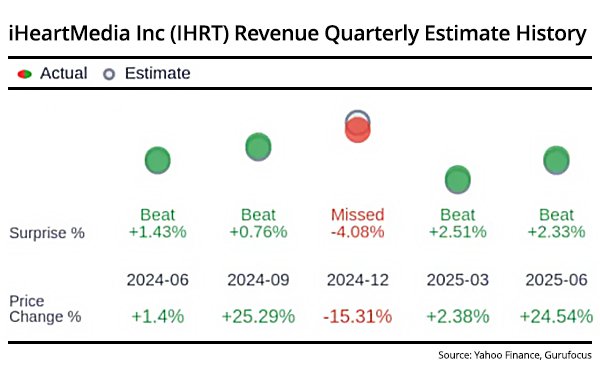
iHeartMedia is scheduled to report Q3 2025
earnings on Monday after the market closes. Although consensus estimates predict a break-even quarter compared with a year ago, that could change in Q4, because of the momentum the company has
seen in the past few weeks.
The Q3 2025 revenue estimate is $980.05 million, and earnings are estimated at $0.00 per share.
Full-year 2025 revenue is expected to be
$3.79 billion, and earnings are expected to be $-2.15 per share.
advertisement
advertisement
Licensing deals are part of what is being watched. Netflix is in talks to license video podcasts distributed
by iHeartMedia as it looks to compete with YouTube, reported Bloomberg, citing people familiar with the discussions.
Investors also will also focus on updates around advertising trends
and digital growth, which have already been announced.
The company made two significant deals during the past week -- one with technology company StackAdapt and the other with Amazon Ads, the
company's advertising arm.
StackAdapt today announced an integration with iHeartMedia that makes AM and FM broadcast radio available programmatically. The airwaves have benefits such as no
cost to the listener, other than trading free music, sports or talk radio for ads, like the internet.
AM and FM radio holds 64% of all daily ad-supported audio listening, according to Nielsen -- driven largely by the strength of local programming, mostly in rural and remote
communities, especially across Wyoming.
This launch between iHeartMedia and StackAdapt signals a new era for audio, according to Greg Joseph, vice president of inventory at StackAdapt.
For the first time, marketers can plan, buy, and measure iHeart’s 278 million monthly listeners across AM and FM, streaming, and podcasts directly within StackAdapt’s platform,
combining the reach of broadcasting with programmatic media.
The integration opens broadcast media to real-time, data-driven activations for all types of brands, as well as political media
buyers preparing for the 2026 midterm elections.
One interesting point is that many AM and FM radio listeners use Alexa, according to iHeartMedia and StackAdapt data. The companies say
broadcast radio remains central to how people consume audio in their homes and cars through Amazon’s Alexa.
It likely explains last week’s announcement from Amazon Ads and
iHeartMedia. Last week the companies announced an expansion of their partnership to give advertisers using Amazon DSP access to iHeart’s complete streaming audio portfolio.
The
partnership combines Amazon’s trillions of shopping, streaming, and browsing signals with iHeart’s millions of listeners across streaming audio for meaningful reach at scale.
It
allows advertisers to connect with listeners across devices like smartphones, smart speakers, tablets, gaming consoles, and more -- including access to iHeartPodcasts and reach for its broadcast radio
stations that will follow in 2026.
The efficiency comes from advertisers now being able to access all of iHeart's streaming audio inventory in one place through one
solution, Amazon DSP. Rather than managing separate solutions and workflows, they can plan, purchase, and measure audio alongside their other digital media in a single interface.
This integration is also part of our broader strategy to simplify the fragmented media landscape. Following Amazon’s partnerships with Spotify and SiriusXM Media, adding iHeart's reach
creates a more comprehensive audio offering from Amazon’s media DSP platform.
For advertisers, this translates to benefits like consolidated campaign management, unified audience
targeting across channels, and integrated measurement.
The full iHeart integration will expand over time, with podcasts and radio broadcasting becoming available programmatically
through Amazon DSP in 2026, further streamlining how advertisers can reach audio audiences at scale.